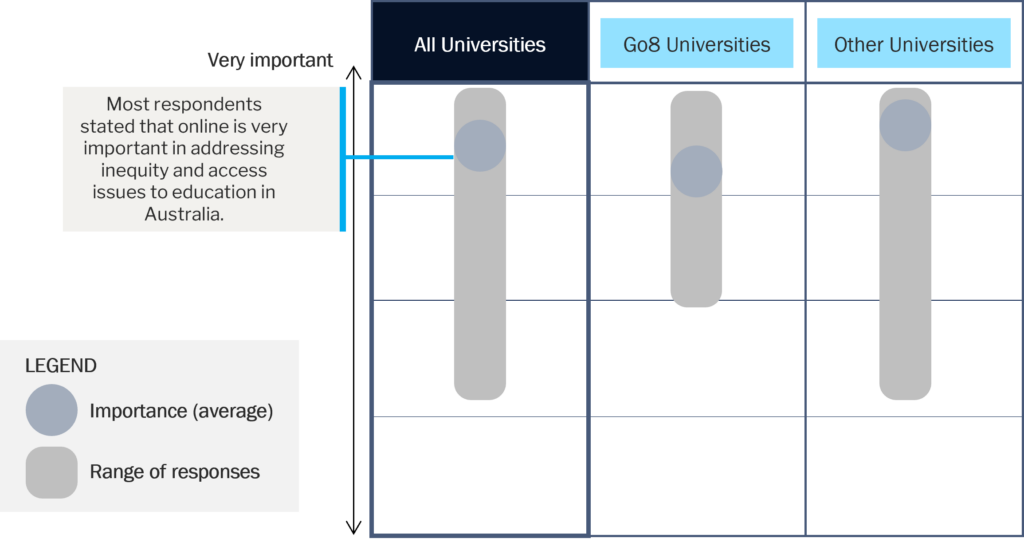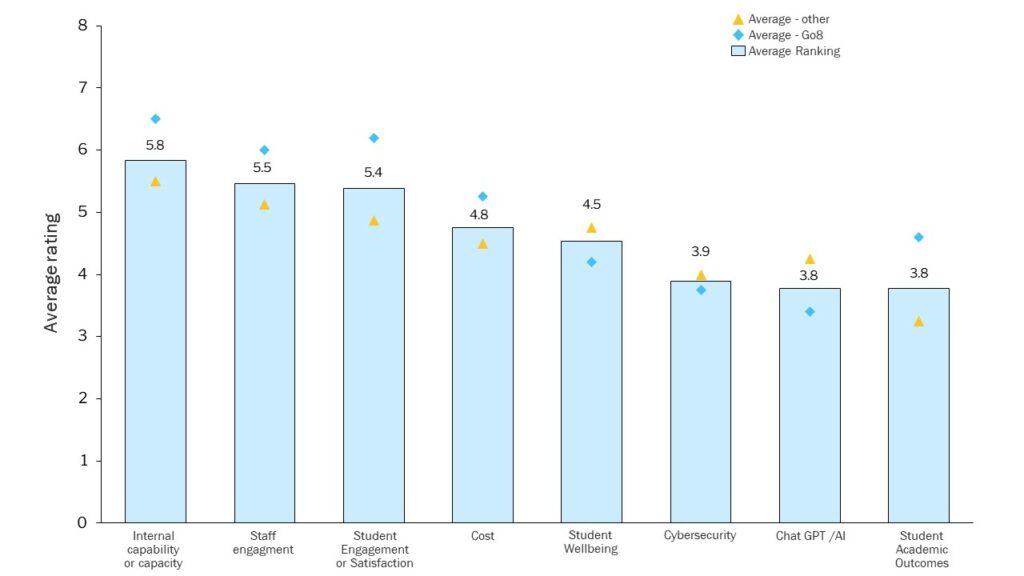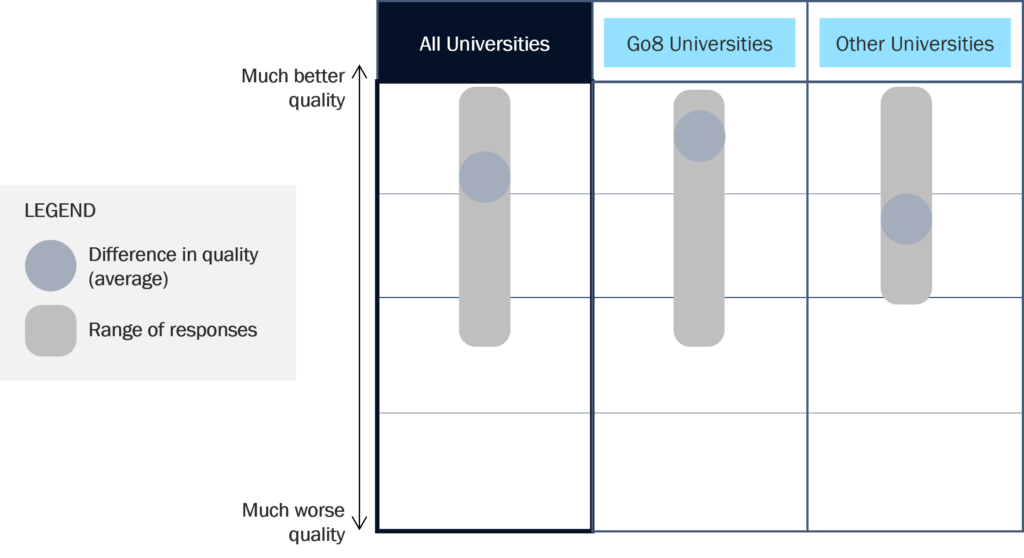Insights
The Future Of Online Education


Insights from interviews with Australian university leaders
Over recent years within SPP’s Higher Education Practice we’ve seen first-hand how the rapid emergence of online education has been at the forefront of major change across the sector. In this context SPP reached out to a cross-section of sector leaders to understand their perspectives on the current online education landscape, and to discuss their predictions for the future.
Listen to Principal Clara Yates and Partner Bruce Bayley discuss the article here:
Key Take-Aways from discussions with sector leaders
- It’s time to move beyond the “face to face vs online” dichotomy
- When looking to online education as a growth engine, universities should focus on market driven opportunities
- Rich data and personalisation are critical benefits of online learnings models that are still largely untapped
- Universities need to be honest with themselves about their capability and capacity to deliver quality online and blended education
- Online offers increased market reach and can help solve a lot of accessibility challenges, but it’s not a panacea
- Cultural barriers to online education among university staff remains a challenge
- Universities shouldn’t underestimate the level of investment required to adapt and thrive in this rapidly evolving environment
Table 1: Research Summary

Online education is at the forefront of massive sector change
The introduction and growth of online education models is driving complex ramifications for universities with significant impacts for students and staff. Students are demanding and expecting greater flexibility and choice around where and how they study, driving increasing demand for more modular, customisable, and digitally advanced education products. Academics and university administrators meanwhile are grappling with how to operate in this new environment, how their roles are changing, and above all how to ensure that quality remains at the forefront of the educational experience.
Through necessity COVID-19 has accelerated the transition to online and prompted many providers to re-think their product mix and mature their approach to online delivery. Similarly, providers are being faced with broader questions about how the shift toward online delivery will impact their operations and how they will need to respond.
It’s clear that we are in the middle of a major disruption, so we were curious to better understand directly from sector leaders how they were thinking about the change.
SPP interviewed 15 senior university leaders from around Australia to gather their perspectives on the current online education landscape and predictions for the future. Our discussions were wide ranging, and broadly encompassed the following areas:
- Perspectives on the current state of online and blended education in Australia.
- The “big picture” challenges and opportunities opened up by online and blended education.
- How Australian universities are evolving to incorporate the shift to online.
- How students and staff are being impacted by the growth of online education.
- How universities are leveraging partners to deliver the best educational experience.
Our consultation yielded six key insights which we hope will provoke thinking and be useful in navigating the path forward.
Insight 1: Online and blended education have a strong role to play in the future growth ambitions of universities
University leaders, almost without exception, see online education as presenting significant growth opportunities for their institutions. Indeed, out of all questions we asked, this question saw the most unanimity across universities.
Most of the respondents believe that online education has a strong role specifically in enabling the development of new educational products, such as new courses and formats.
More broadly, our interviewees believe that online education will affect considerable change across their institutions generally, though there were widely ranging views about the extent of its impact. Some felt the change would be transformative, while others thought it would be relatively minor.
Insight 2: We need to move beyond the face-to-face vs online dichotomy
Among university leaders we spoke to, a clear view emerged that it is no longer useful to talk about online and face-to-face as two separate, opposing models of higher education delivery. The question is not whether, but how and when to combine and integrate elements of online and face-to-face in teaching and student administration systems.
Everyone we spoke to agreed that they want to see more integration between wholly online and face-to-face activities. However, there was a distinct difference between Group of Eight (Go8) and other universities; Go8 both currently have and seek in the future a markedly lower level of integration than others. This reflects an ongoing desire of Go8 institutions to focus on the traditional on-campus experience as an expression of their value proposition. Other universities are intentionally embracing more hybrid/integrated delivery models to differentiate themselves in the market.
Insight 3: There are valuable opportunities to leverage data from online platforms to improve student learning and experience
Moving online has provided universities with access to a goldmine of data pertaining to student behaviours and engagement, academic outcomes and student and staff experience. The university leaders we spoke to agreed that the increased data transparency enabled by online is allowing universities to get smarter about what works well in terms of educational experience and outcomes for different students in different disciplines – including in face-to-face teaching.
This kind of access to data may help universities achieve greater personalisation – described by one interviewee from a regional university described as “the holy grail of the learning journey”.
Insight 4: Online Program Management providers (OPMs) will remain integral but in new configurations
Most universities we spoke to currently rely to some degree on third party OPMs (e.g. Online Education Services, Keypath Australia) to deliver online and blended experiences. Some universities initially worked with OPMs and have gone on to develop their own capability and infrastructure.
For many universities, OPMs play an important role in driving efficiency and innovation in the delivery of online education, with particular expertise in digital marketing and recruitment and data analytics.
It is expected that OPMs will continue to play an ongoing role in online education in the future. However, many universities will be looking to engage them in a more targeted way, using only specific functions rather than the full end-to-end service and maintaining greater control over presentation and distinctiveness of their courses.
“There is nothing better than having an external trusted party who has skin in the game and a contract to deliver with the university. Everyone benefits.”
Senior executive, regional university
“We partnered with an OPM provider to develop a suite of courses that were financially viable. [We learnt from] the more business-led approach. It led to us re-engineering our own course development and we no longer rely on OPMs.”
Senior executive, regional university
“We need a better relationship with OPMs to put our own lens on the look and feel of online courses, and to make sure we stay unique with our online offerings.”
Senior educational leader, Go8 university
Insight 5: Online is considered very important in addressing inequity and access issues in Australia
On average, across all university sectors, online is seen as an important equaliser of access to higher education. One interviewee from an IRU university noted that the greater equity and reach enabled by online applies not only to regional and remote students, but to people who are neurodivergent, have a disability, have families and who work.
This positive evaluation, however, was not without qualification. One interviewee from a technology university, for example, noted that not all students are “digitally native”, which is often assumed to be the case. In reality, digital capability is often dependent on socio-economic background and other factors, and some students may be disadvantaged by the expectation of online access and capability.
Figure 1: Responses to Interview Question: “How Important is online/ digital in addressing in equity and lack of access to education in Australia?“

Insight 6: COVID-19 accelerated the development of online education but staff capability and engagement are lagging
Figure 2: Responses to Interview Question: “What are your University’s top concerns as universities move into a more technology-enabled environment?“
COVID-19 forced a huge leap forward in technology utilisation and online content delivery, but many academic staff are struggling to keep up with the demands of this new digital education age. University leaders we spoke to rated “internal capability or capacity” and “staff engagement” as their two most pressing concerns as universities move into a more technology enabled learning environment.
(1 = smallest concern, 8 = biggest concern)

Many staff feel that they are not developing skills and capabilities fast enough to keep up with the new learning tools and technologies being implemented. While some universities are rolling out frameworks, guidelines and internal professional development, most are at still at very early stages. Some academics are also grappling with what online education means for the traditional teaching role of academics.
The stakeholders we interviewed reported varying levels of “online maturity” at their universities. Some of the interviewees at Go8 universities noted that their more “traditionalist” orientation meant that they had found it more difficult institutionally to adopt online innovations.
Notwithstanding these concerns, most of our interviewees believed, somewhat surprisingly, that that online units that are thoughtfully designed and utilise high quality pedagogy are better quality than some face-to-face experiences.
Figure 3: Responses to Interview Question: “What is your perception around the quality of online & blended learning (relative to traditional face-to-face experiences)?“

Conclusion
Online education is, without a doubt, here to stay. It is considered by university leaders to be an important factor driving growth in their institutions and increasing equity and access to higher education for diverse student populations. Greater integration of data and insights from online education has the potential to personalise the student experience and enhance learning outcomes.
However, significant challenges remain: how best to support academic staff to keep up with the ever evolving demands and technologies of online and blended learning; finding new ways to maintain student engagement and social connectedness in an online environment; and how best to maintain the distinctiveness and quality of courses when utilising the services of OPMs. What will universities need to do to leverage the opportunities and respond to the challenges of online education into the future?
We have identified six “calls to action”:
- Continue to focus on understanding the education market’s growth areas – particularly through a postgraduate and short course lens – to identify the emerging and unmet needs and how the online model can service these requirements.
- Universities need to think deeply about how to integrate elements of the online model with their on-campus learning experience. How can elements such as enhanced digital marketing, sales support teams, data-informed decision-making and virtual student support models improve university and student outcomes?
- Universities will need to explore how best to utilise the rich data and feedback loops available from a more online education model to personalize and enhance the student experience and enhance learning outcomes. This has the potential to significantly change elements of teaching and student support.
- It will be essential for universities to consider how their use of OPMs should evolve to best suit their needs. A particular area where OPMs will continue to provide expertise and insight is helping with integration of systems to support students across the value chain – a business element that is often costly and complex for universities to implement.
- Universities should continue to leverage the broader reach of online programs to access target student cohorts. At the same time, the focus needs to remain on success and inclusion, with a recognition that equity students will require additional wrap-around support throughout their journey.
- Continuing and increased attention will need to be given to addressing cultural barriers to the adoption of online education (including promotion of the many benefits) and developing the capability of staff to ensure the continuous improvement of the quality of online education.
We welcome a conversation with higher education providers looking to respond to address these imperatives and develop their online education strategy and capabilities.
Key Contacts
Bruce Bayley / Partner
Bruce Bayley is a Partner at SPP and has built strong expertise and connections in the Education and Government sectors. At the University of Melbourne, he held positions including Director of Strategy and Commercialisation and VP International. Bruce has...
Connect on email
Connect on LinkedIn
Clara Yates / Principal
Clara Yates is a Principal at SPP and works closely with organisations to tackle their major strategic challenges. Clara brings particular expertise in the Education sector having worked with Universities, VET providers, Online Education Providers, Research Institutes and education...
Connect on email
Connect on LinkedIn


